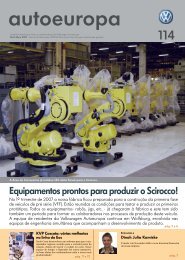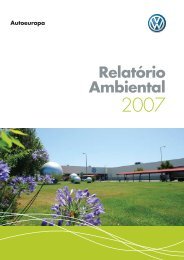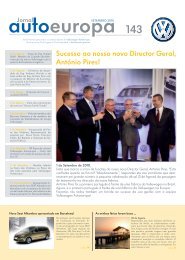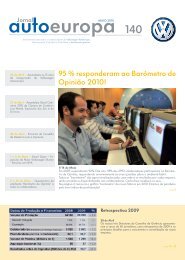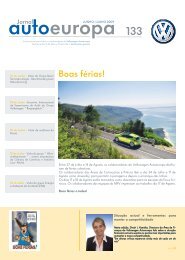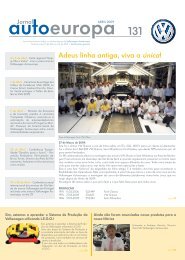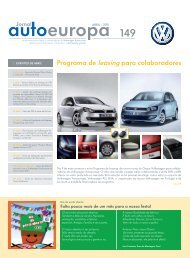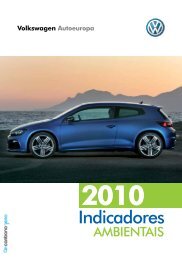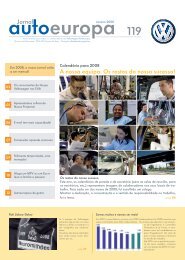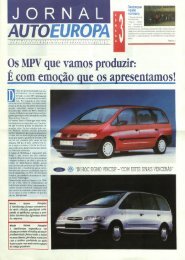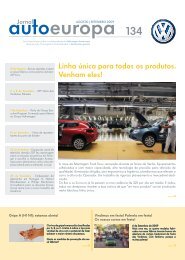Environmental Report - Volkswagen Autoeuropa
Environmental Report - Volkswagen Autoeuropa
Environmental Report - Volkswagen Autoeuropa
You also want an ePaper? Increase the reach of your titles
YUMPU automatically turns print PDFs into web optimized ePapers that Google loves.
<strong>Autoeuropa</strong><br />
<strong>Environmental</strong><br />
<strong>Report</strong><br />
2007
<strong>Autoeuropa</strong><br />
<strong>Environmental</strong><br />
<strong>Report</strong><br />
2007<br />
© <strong>Volkswagen</strong> <strong>Autoeuropa</strong>
Contents<br />
P 04<br />
1.<br />
ENVIRONMENTAL STRATEGY<br />
Management commitment<br />
<strong>Environmental</strong> Policy<br />
P 10<br />
2.<br />
WHAT IS VOLKSWAGEN AUTOEUROPA<br />
Plant<br />
Products<br />
Process<br />
P 16<br />
3.<br />
ENVIRONMENTAL CERTIFICATION AND LICENSING<br />
Evolution of the <strong>Environmental</strong> Management System<br />
The <strong>Environmental</strong> Control and the ISO14001 Team<br />
Internal audits<br />
Emergency response<br />
<strong>Environmental</strong> training and awareness<br />
Organization and cleanliness<br />
2
<strong>Environmental</strong> <strong>Report</strong> 2007<br />
4.<br />
ENVIRONMENTAL ASPECTS AND THEIR CONTROL<br />
P 22<br />
<strong>Environmental</strong> aspects<br />
Waste<br />
Wastewaters<br />
Atmospheric emissions<br />
Noise<br />
Water consumption<br />
Natural gas consumption<br />
Energy consumption<br />
Soil protection<br />
Materials approval<br />
Transportation<br />
Influence over suppliers<br />
5.<br />
ENVIRONMENTAL OBJECTIVES AND RESULTS<br />
P 32<br />
Objectives and results 2007<br />
Some examples of implemented programmes<br />
Objectives for 2008<br />
6.<br />
ENVIRONMENTAL INDICATORS<br />
P 42<br />
Vehicle production<br />
Consumption of natural resources and energy<br />
Atmospheric emissions<br />
Waste production<br />
Wastewaters<br />
<strong>Environmental</strong> noise<br />
7.<br />
ENVIRONMENTAL COSTS AND INVESTMENTS<br />
Running costs<br />
Investments<br />
P 52<br />
3
766,03<br />
0,72<br />
342
222,4<br />
(Kg/h)<br />
42,306<br />
1.<br />
<strong>Environmental</strong><br />
strategy
Management<br />
commitment<br />
Nowadays, the environment and the efficient management of<br />
the natural resources and energy, along with the economical and<br />
social factors are the base pillars of the modern and developed<br />
countries, as well as the guidelines of the solid companies.<br />
In order to achieve a sustained growth, <strong>Volkswagen</strong> <strong>Autoeuropa</strong><br />
promotes these fundamental variables and reaffirms its<br />
commitment to the fulfilment of the objectives of environmental<br />
responsibility.<br />
We design processes aiming for the efficient use of resources,<br />
minimizing the energy consumption, the production of<br />
emissions and waste, seeking for a low environmental impact.<br />
Moreover, we advise and influence our suppliers to act in line<br />
with our <strong>Environmental</strong> Policy.<br />
In the daily work we reinforce continuously our efforts in the<br />
accomplishment of the <strong>Environmental</strong> Policy, by promoting<br />
the necessary training and education to our collaborators, by<br />
attributing them a clear responsibility and mission in this scope<br />
and by creating an environmental awareness.<br />
We will support changes in processes and the use of<br />
alternative energies and we bear in mind that the existing<br />
natural resources are not unlimited, and that there is the<br />
urgent need to encourage their rational use and exploitation.<br />
Therefore, we will reinvent new methods and strive for the<br />
preservation of our common heritage and its transmission to<br />
the coming generations.<br />
The objective of the present <strong>Report</strong> is the publication of the<br />
results of our environmental performance in 2007.<br />
Andreas Hinrichs<br />
Executive Director of<br />
<strong>Volkswagen</strong> <strong>Autoeuropa</strong><br />
6
<strong>Environmental</strong> <strong>Report</strong> 2007<br />
<strong>Environmental</strong> strategy<br />
In 2007, we renewed our environmental certification<br />
for the third time.<br />
As the management representative for the<br />
environmental issues, this fact is a motive of great<br />
satisfaction for my team and me.<br />
In current times, it’s no longer possible for a big<br />
company like <strong>Volkswagen</strong> <strong>Autoeuropa</strong>, to do<br />
business with a long-term view not addressing the<br />
environmental matters as part of its strategy. Adopting<br />
sustainability as a way of doing things ensures not<br />
only the reduction of the environmental impacts of<br />
our activity, but also the baseline for our economic<br />
growth and the social recognition of the work we’ve<br />
been developing.<br />
By involving our main suppliers in this process, we<br />
share with them the environmental challenge that we<br />
assumed ourselves, and create synergies that lead to<br />
much better global results than the ones we would<br />
achieve on our own.<br />
Year after year is harder and harder to define new<br />
objectives and improvement opportunities, as well<br />
as to positively respond to an increasing pressure<br />
of the legislative evolution. Yet I’m confident that<br />
<strong>Volkswagen</strong> <strong>Autoeuropa</strong> will continue to do its best<br />
on this field, and will continue to be recognised as<br />
leader in protecting the environment.<br />
Within the frame of the current climate changes<br />
and the urgent need to rationally use natural and<br />
energetic resources, industry has an increasing<br />
responsibility towards the adoption of a responsible<br />
and sustainable attitude. Ecoefficiency provides<br />
the only way for industry to grow economically<br />
yet maintaining its commitment to preserve the<br />
environment for the future generations.<br />
It is important that we’re daily aware of the impact<br />
of our gestures and all that lies in our hands to<br />
do: saving water and energy, adequately segregate<br />
waste to enable its recovery whenever possible,<br />
efficiently control of activities and equipment. But<br />
being aware is not enough, we must act. We must<br />
be the driving force for changes, either internally<br />
or in partnership with our suppliers. I believe this a<br />
vision worth fighting for.<br />
To give our best for a good harmony with the<br />
environment is not an option but a mission… This<br />
mission is the foundation of the <strong>Environmental</strong><br />
Management System of <strong>Autoeuropa</strong> that I’m<br />
proud of as a manager and a citizen. And when I<br />
receive the very positive comments issued by our<br />
certification body year over year, I know we’re on<br />
the right way and get motivated to support new<br />
and more ambitious environmental objectives.<br />
Bruno Torres<br />
Planning, Environment and<br />
Infrastructures Area Manager<br />
Pedro Lourenço<br />
Infrastructures and Environment<br />
Manager<br />
7
8
<strong>Environmental</strong> <strong>Report</strong> 2007<br />
<strong>Environmental</strong> strategy<br />
<strong>Environmental</strong> Policy<br />
It is the global environmental policy and strategy of <strong>Volkswagen</strong> <strong>Autoeuropa</strong> to<br />
become a recognised leader in protecting the environment.<br />
This <strong>Environmental</strong> Policy Statement covers all activities at the Palmela plant,<br />
whether directly or indirectly involved with the manufacture of our products.<br />
It is also <strong>Volkswagen</strong> <strong>Autoeuropa</strong> policy to seek for continual improvement in<br />
environmental performance, and where possible to control environmental aspects at<br />
the source. In particular we aim to:<br />
• Meet or go beyond<br />
environmental legal and other<br />
requirements.<br />
• Maintain procedures and means<br />
to deal promptly and effectively<br />
with environmental emergencies.<br />
• Establish objectives and<br />
programmes for the reduction<br />
of environmental impacts of<br />
our activities.<br />
• Ensure that the environmental<br />
aspects of new manufacturing<br />
processes, works and related<br />
service activities are analysed.<br />
• Promote an increase of valueadding<br />
destinations for waste.<br />
• Ensure a clear definition of<br />
environmental objectives and<br />
responsibilities.<br />
• Influence our contractors and<br />
suppliers in order to meet<br />
the <strong>Volkswagen</strong> <strong>Autoeuropa</strong><br />
environmental requirements.<br />
• Create or maintain green<br />
areas within or in the<br />
neighbourhood of <strong>Volkswagen</strong><br />
<strong>Autoeuropa</strong>.<br />
9
H 2<br />
0<br />
65<br />
0,33
766,03<br />
(ml/m 3 )<br />
33<br />
2.<br />
What is<br />
<strong>Volkswagen</strong><br />
<strong>Autoeuropa</strong>
Plant<br />
<strong>Volkswagen</strong> <strong>Autoeuropa</strong><br />
is located in the<br />
Setúbal Peninsula,<br />
more specifically in the<br />
Palmela municipality.<br />
The total plot area of the<br />
plant is 1 133 339 m 2<br />
with a covered area of<br />
245 139 m 2 .<br />
It was built on a previously unoccupied site,<br />
north of the Lisbon / Algarve highway, south<br />
of the Lisbon / Setúbal railway, and next to the<br />
Penalva railway station.<br />
The <strong>Volkswagen</strong> <strong>Autoeuropa</strong> plant was built<br />
between 1991 and 1994, having started series<br />
production in 1995. It has an installed capacity<br />
for the production of 180 000 vehicles per<br />
year, if operating in 3 shifts. It is the result of a<br />
1970 million euros investment and constitutes<br />
one of the most modern industrial units in<br />
portuguese territory.<br />
Since the initial layout, the plant was already<br />
subjected to a wide set of extensions and<br />
upgrades, having in view the production of<br />
new models. However, an effort to optimise<br />
and reuse the existing buildings was done, in<br />
order to prevent unnecessary soil occupation.<br />
A8<br />
A1<br />
Tejo Estuary<br />
Reserve<br />
Porto<br />
Alto<br />
Vasco da<br />
Gama bridge<br />
Penalva<br />
Railway Station<br />
Cascais<br />
A5<br />
25 de Abril<br />
bridge<br />
LISBON<br />
Montijo<br />
River Tagus<br />
Moita IC32<br />
Barreiro<br />
A12<br />
A2<br />
Visitors<br />
Industrial<br />
Park<br />
A2<br />
<strong>Autoeuropa</strong><br />
Industrial<br />
Park<br />
Atlantic<br />
Ocean<br />
Arrábida<br />
Natural Park<br />
Palmela<br />
SETÚBAL<br />
Sado<br />
Estuary<br />
Reserve<br />
Tróia<br />
Makro<br />
A2<br />
Setúbal Peninsula<br />
Industrial Park of <strong>Autoeuropa</strong><br />
12
<strong>Environmental</strong> <strong>Report</strong> 2007<br />
What is <strong>Volkswagen</strong> <strong>Autoeuropa</strong><br />
Products<br />
The year 2007 was dominated by<br />
all plant preparations to produce<br />
the <strong>Volkswagen</strong> Scirocco, a new<br />
model inspired by the legendary<br />
product of the 70’ that will enter<br />
the market as from the first<br />
semester of 2008.<br />
The new Scirocco was presented to the public in<br />
2006 still as a concept-car and in 2007 was partially<br />
redesigned to its final shape and approved by the<br />
<strong>Volkswagen</strong> Board.<br />
The main modification to accommodate this new<br />
model in the plant was the installation of a brand<br />
new body construction line, where innovative<br />
technologies were introduced, e.g.: laser brazing<br />
and indirect spotwelding (used for the first time in<br />
<strong>Volkswagen</strong> Group). In the remaining areas of the<br />
plant there weren’t any changes in equipment or<br />
technology, given the fact the Scirocco will be built<br />
in the same line as the current <strong>Volkswagen</strong> Eos.<br />
93 609 vehicles were produced during 2007 and the<br />
Eos represented about 60% of the total. Regarding<br />
the multipurpose vehicle segment (MPVs), that<br />
was the reason for <strong>Volkswagen</strong> <strong>Autoeuropa</strong> to<br />
be established, 38 049 units were produced. The<br />
<strong>Volkswagen</strong> Sharan and the SEAT Alhambra<br />
corresponded to 25 and 15%, respectively, of the<br />
total volume produced in 2007.<br />
Still in 2007, the <strong>Volkswagen</strong> Eos enabled the<br />
<strong>Volkswagen</strong> brand to be awarded as the first<br />
worldwide manufacturer to anticipate compliance<br />
with the recyclability targets for end-of-life<br />
vehicles.<br />
13
14
<strong>Environmental</strong> <strong>Report</strong> 2007<br />
What is <strong>Volkswagen</strong> <strong>Autoeuropa</strong><br />
Process<br />
1<br />
2<br />
3<br />
The vehicle manufacturing process at<br />
<strong>Volkswagen</strong> <strong>Autoeuropa</strong> is sequential and<br />
begins with the cutting of the different<br />
panels from steel coils in the press-shop.<br />
A single press-shop produces the panels<br />
for all models manufactured at <strong>Volkswagen</strong><br />
<strong>Autoeuropa</strong> although some parts come<br />
from external suppliers.<br />
The next step is the body construction,<br />
where the vehicle structure is built using<br />
different welding and sealing technologies.<br />
6<br />
7<br />
The assembly process is carried out in<br />
two independent lines. One of these,<br />
the older, is solely dedicated to produce<br />
the MPVs Sharan and Alhambra. In the<br />
other one, younger and more flexible,<br />
the Eos is currently produced and in the<br />
near future the Scirocco as well.<br />
Common check and test zones await all<br />
models at the end of the assembly lines,<br />
and those include a water-test and a<br />
test-track. The expedition area is also<br />
common to all models.<br />
1<br />
4<br />
At <strong>Volkswagen</strong> <strong>Autoeuropa</strong>, the welding<br />
lines for the MPV, the Eos and the future<br />
Scirocco are independent, but they get<br />
together in a common metal finishing area<br />
before the vehicles are delivered to the<br />
paint-shop.<br />
2 3<br />
5<br />
The next step is the painting of the<br />
finished body, and all models pass through<br />
the single existing paint-shop.<br />
4 5 6 7<br />
15
766,03<br />
(ml/m 3 )<br />
2,02<br />
332
66,01<br />
3.<br />
<strong>Environmental</strong><br />
Certification<br />
and Licensing
18
<strong>Environmental</strong> <strong>Report</strong> 2007<br />
<strong>Environmental</strong> Certification and Licensing<br />
Evolution of the <strong>Environmental</strong><br />
Management System<br />
In 1998, <strong>Volkswagen</strong> <strong>Autoeuropa</strong> established an <strong>Environmental</strong> Management<br />
System (EMS) according to the requirements of the ISO 14001:1996 Standard.<br />
The system was certified by the VCA (Vehicle<br />
Certification Agency) in December 1998, and<br />
this certification has been renewed threefold<br />
(2001, 2004 and 2007). Every semester, followup<br />
audits are conducted by VCA, and every three<br />
years the ISO 14001 certification is renewed.<br />
During 2005 the successful EMS transition to the<br />
ISO 14001:2004 Standard was conducted, with<br />
the attainment of the respective certificate in<br />
December.<br />
<strong>Volkswagen</strong> <strong>Autoeuropa</strong> is also detainee of the<br />
<strong>Environmental</strong> Licence nr. 01/2004 issued by the<br />
Environment Ministry in February 2004, thus<br />
anticipating compliance in more than 3 years<br />
with the dead-line established by the European<br />
Commission.<br />
The <strong>Environmental</strong> Control<br />
and the ISO14001 Team<br />
<strong>Volkswagen</strong> <strong>Autoeuropa</strong> has a section designated as <strong>Environmental</strong><br />
Control, within the Infrastructures and Environment division.<br />
The <strong>Environmental</strong> Control consists of a team<br />
of two engineers dedicated to the actions of<br />
environmental control and to the coordination<br />
and maintenance of the EMS.<br />
The EMS, in turn, manages and controls all<br />
environmental aspects of the plant, and also includes<br />
the programmes necessary to the continuous<br />
improvement of the environmental performance. It<br />
also includes the tools to evaluate environmental<br />
performance evaluation, legal compliance and<br />
compliance with the ISO 14001:2004 Standard.<br />
The <strong>Environmental</strong> Control is supported by a<br />
group of representatives from each area of the<br />
plant which, as a group, form the ISO 14001<br />
Team. This team has meetings every two weeks,<br />
focussing on, amongst others, the EMS operation<br />
as well as its improvements.<br />
Some of the most important functions of the ISO<br />
14001 Team are to ensure the EMS maintenance in<br />
each area and to provide all necessary information<br />
and indicators for the evaluation of the plant’s<br />
environmental performance.<br />
Internal audits<br />
The main tools used for the evaluation of the efficiency of the EMS<br />
are the internal audits and the management reviews.<br />
In the annual internal audits programme, about<br />
20, all areas are contemplated, and have all the<br />
requirements of the ISO 14001 Standard and the<br />
legal requirements as their baseline. These audits<br />
are undertaken by a group of internal auditors. The<br />
results are weekly reported to the Area Managers.<br />
The results of the internal audits, of the<br />
environmental objectives, and of a whole set<br />
of performance indicators, are analysed by the<br />
management twice a year. The management<br />
reviews produce new environmental objectives<br />
and recommendations for improvement.<br />
19
20
<strong>Environmental</strong> <strong>Report</strong> 2007<br />
<strong>Environmental</strong> Certification and Licensing<br />
Emergency response<br />
One of the essential rules of an EMS is to be<br />
prepared to react to emergency situations which<br />
may cause environmental impacts. <strong>Volkswagen</strong><br />
<strong>Autoeuropa</strong> has a private fire-fighting brigade with<br />
diverse means at its disposal for fire-fighting and<br />
controlling other risk situations.<br />
The fire-fighting brigade service is ensured 24<br />
hours a day during the whole year by elements with<br />
training in the areas of intervention and prevention.<br />
These fire-people are capacitated to conduct rescue<br />
and recovery operations, to deliver first aid and to<br />
transport the hurt and ill, being able to intervene<br />
with an ambulance, a heavy auto tank, a light firstaid<br />
vehicle and a chemical intervention vehicle for<br />
eventual accidents involving hazardous substances.<br />
In certain emergency scenarios, there is a risk<br />
that hazardous substances are able to enter the<br />
rainwater network (e.g. accident with tanker-truck,<br />
contaminated waters from fire-fighting, piping<br />
rupture, etc.). The plant has a cut-off valve at the<br />
exit of the rainwater network, which allows the<br />
containment of eventual hazardous substances and<br />
contaminated waters, up to a volume of 4000m 3 . In<br />
this way, the aquatic environment is protected.<br />
<strong>Environmental</strong> training and awareness<br />
The training and awareness of workers and suppliers<br />
on environmental matters is another concern at<br />
the plant. All the people who exercise activities<br />
within the company, including the rendering of<br />
services, receive training on environmental issues<br />
and emergency response, taught internally through<br />
awareness sessions.<br />
Just like the <strong>Volkswagen</strong> <strong>Autoeuropa</strong> workers, so<br />
must the internal suppliers know and respect the<br />
environmental policy, as well as the basic rules on<br />
environment and safety, distributed in the form<br />
of pamphlets in specific meetings or during the<br />
awareness sessions.<br />
The existing environmental training includes,<br />
Organization and cleanliness<br />
The objective of the organization and cleanliness<br />
audits is, to ensure in a standardized approach, the<br />
good operational conditions based on a workplace<br />
organization philosophy in all production, nonproduction<br />
and social areas.<br />
In order to achieve this objective, the audits<br />
focus themselves on the effective implementation<br />
and maintenance of the essential ergonomics,<br />
apart from the previously mentioned obligatory<br />
awareness sessions, specific courses oriented to<br />
particular target-groups, namely:<br />
• Handling and transport of hazardous materials<br />
• <strong>Environmental</strong> legislation<br />
• <strong>Environmental</strong> management<br />
• Internal ISO 14001 auditors<br />
The environmental training and awareness given<br />
to all individuals who work within <strong>Volkswagen</strong><br />
<strong>Autoeuropa</strong> helps to elevate the degree of<br />
internal conscience and responsibility where the<br />
environment is concerned.<br />
functionality, accident prevention and waste<br />
prevention rules.<br />
This tool provides indirect support to the EMS,<br />
by evaluating aspects like the correct waste<br />
segregation, the adequate identification of waste<br />
bins, and the existence of retention systems<br />
where applicable, or the labelling and handling of<br />
hazardous substances and materials.<br />
21
32,03<br />
(km/s)<br />
9,82
422<br />
4.<br />
<strong>Environmental</strong><br />
aspects and<br />
their control
24
<strong>Environmental</strong> <strong>Report</strong> 2007<br />
<strong>Environmental</strong> aspects and their control<br />
<strong>Environmental</strong> aspects<br />
<strong>Environmental</strong> aspects are understood<br />
to be all the possible forms of<br />
the company’s interaction with<br />
the environment, such as all the<br />
consumptions of natural resources and/<br />
or energy, as well as the production<br />
of liquid or atmospheric effluents, of<br />
waste, or the emission of noise to the<br />
surroundings of the plant.<br />
If they are not adequately<br />
controlled, these aspects may cause<br />
environmental impacts. The objective<br />
of environmental management,<br />
through its EMS, and the activity of the<br />
<strong>Environmental</strong> Control, is to guarantee<br />
through an adequate management of<br />
environmental aspects, the prevention<br />
of the occurrence of significant<br />
environmental impacts.<br />
The best way for an organization<br />
to reduce its environmental impact<br />
is to, cumulatively, minimise its<br />
consumption of resources (water,<br />
natural gas, raw materials) and, by<br />
minimizing the production of waste,<br />
reduce the discharge of effluents<br />
(liquid and atmospheric) and the noise<br />
emission to the outside. These are the<br />
principles of eco-efficiency. In this<br />
chapter we present a summary of the<br />
<strong>Volkswagen</strong> <strong>Autoeuropa</strong> approach in<br />
respect to the control of environmental<br />
aspects.<br />
Water<br />
Energy<br />
Raw<br />
materials<br />
Wastewaters<br />
Atmospheric<br />
emissions<br />
Waste<br />
Noise<br />
Waste<br />
At <strong>Volkswagen</strong> <strong>Autoeuropa</strong>, the<br />
various types of waste produced<br />
can be divided in two large groups:<br />
hazardous and non-hazardous.<br />
These wastes are grouped according<br />
to their nature, managed separately,<br />
stored and shipped to licensed<br />
operators, with preference being<br />
given to operators providing<br />
recovery operations whenever<br />
technically and economically<br />
viable.<br />
<strong>Volkswagen</strong> <strong>Autoeuropa</strong> celebrated<br />
a total waste management contract<br />
with a dutifully licensed operator,<br />
which ensures all the internal<br />
collection, packing and labelling.<br />
The same operator also coordinates<br />
all logistics of waste shipment to<br />
the recovery and disposal operators,<br />
and organises all documentation<br />
required by national and European<br />
applicable legislation.<br />
It has been the company policy<br />
to work so as to reduce the waste<br />
produced and to raise the recovery<br />
rate of the same.<br />
25
For an adequate management of all different types of produced waste,<br />
<strong>Volkswagen</strong> <strong>Autoeuropa</strong> has got four dedicated installations:<br />
A non-hazardous waste segregation<br />
centre, where the separation and compacting<br />
of cardboard packages (including office paper),<br />
plastic film and common industrial waste takes<br />
place, as well as the separation of wood waste.<br />
A hazardous waste park, dully covered,<br />
waterproofed and with a connection to the IWWTP<br />
(industrial wastewater treatment plant), where all the<br />
hazardous waste produced in the plant (such as are the<br />
cases of paint sludge, phosphate sludge, IWWTP sludge,<br />
waste oils and hydrocarbons, car batteries, glue and sealer<br />
waste, used solvents, small batteries, fluorescent lamps<br />
and contaminated packages, among others) are classified,<br />
conditioned, labelled and prepared for transportation.<br />
A scrap recovery centre, where waste such as<br />
damaged vehicle parts and components (metallic<br />
and non-metallic), glass, copper, aluminium,<br />
obsolete electrical and electronic equipment, other<br />
obsolete equipment from the plant, and some waste<br />
from works and modifications in the plant, are<br />
segregated and, in certain cases, compacted.<br />
A baler-house for compacting of metal<br />
shreds, which are the leftovers from cutting out of<br />
the various panels that constitute the vehicle body;<br />
in this plant, the metal shreds are automatically<br />
pressed and discharged into rail wagons.<br />
Apart from these dedicated areas, there are numerous<br />
containers for the adequate waste segregation all over<br />
the plant, both inside the buildings and close to the<br />
contractor’s compound.<br />
The total waste management is a very important part of<br />
the EMS, having resulted in the definition of a number<br />
of procedures, instructions and visual aids to assist the<br />
process, so that all the operations associated with waste<br />
take place in an integrated way. There is a colour code<br />
for the various waste containers, and synoptic posters<br />
were created to illustrate the type of containers and<br />
their function.<br />
26
<strong>Environmental</strong> <strong>Report</strong> 2007<br />
<strong>Environmental</strong> aspects and their control<br />
Wastewaters<br />
<strong>Volkswagen</strong> <strong>Autoeuropa</strong> has independent networks<br />
for rainwater, sanitary and industrial effluents,<br />
which are respectively identified with the colours:<br />
blue, brown and purple. The quality of the rainwater<br />
is assured through the existence of oil separators in<br />
the parking lots and in various places in the plant,<br />
and also through the existence of the, previously<br />
mentioned, cut-off valve at the exit of the rainwater<br />
network. This way, the discharge of pollutant<br />
substances into the aquatic environment through<br />
the rainwater network is avoided. The rainwater,<br />
which leaves the plant, is conducted into a small<br />
tributary of the River Tagus (Vala das Sete Fontes).<br />
The sanitary effluent, originating from toilets,<br />
locker-rooms and kitchens, is totally treated in the<br />
municipal WWTP (wastewater treatment plant)<br />
of Palmela, and later introduced in the same<br />
hydrological basin mentioned above.<br />
Finally, the industrial effluents network serves,<br />
as well as the main production buildings, areas<br />
such as the contractor’s compound, the waste<br />
management installations, the cooling water and<br />
compressor stations, the storage areas for chemical<br />
products, among others.<br />
The industrial effluents are all treated at the<br />
physical-chemical IWWTP (industrial wastewater<br />
treatment plant) of <strong>Volkswagen</strong> <strong>Autoeuropa</strong> through<br />
technologies that include, among others, the ultrafiltration<br />
and the flocculation/settling. During 2007, a<br />
study was initiated with the view of implementing a<br />
supplementary treatment process based on activated<br />
carbon, which is foreseen to be running in 2008.<br />
After treatment at the IWWTP of <strong>Volkswagen</strong><br />
<strong>Autoeuropa</strong>, the industrial effluents are sent to<br />
the municipal WWTP of Palmela (for further<br />
treatment, this time biological). The effluent<br />
is conducted, via a sewer, from the IWWTP of<br />
the plant to the municipal WWTP, not allowing<br />
any contact between the industrial effluents<br />
and the natural environment. The quality of the<br />
effluents is controlled on a daily basis by the<br />
IWWTP operators, and fortnightly by an external<br />
laboratory. The results are sent to the regional<br />
environmental authority (CCDR) every semester.<br />
The water used in the paint booths is treated<br />
through a specific physical-chemical process, and<br />
continually re-used. In the end, this process allows<br />
the re-circulation of water within a closed circuit<br />
(after removal of the paint overspray, lost during<br />
the paint process) and, as such, assures <strong>Volkswagen</strong><br />
<strong>Autoeuropa</strong> relatively low water consumption,<br />
when compared to most automotive plants.<br />
27
Atmospheric emissions<br />
The paint process used by <strong>Volkswagen</strong> <strong>Autoeuropa</strong><br />
is essentially water based (exception goes for the<br />
final clearcoat). This allows one of the lowest<br />
emission rates in the automotive industry. The<br />
average emission in the paint process, in the<br />
previous years, was 33g of volatile organic<br />
compounds (VOC’s) per m 2 of painted surface, where<br />
the limit is 60g/m 2 . Even so, the plant is equipped<br />
to control and reduce its emissions, especially<br />
those of volatile organic compounds (solvents) to a<br />
minimum. Associated to the car drying ovens (after<br />
application of each layer of surface treatment), there<br />
are incinerators, operating at 750ºC, to completely<br />
destroy the residual solvent vapours. Three<br />
incinerators are presently being used.<br />
Apart from the VOC’s, other pollutants resulting<br />
from the automotive manufacturing are: particles,<br />
carbon monoxide and nitrogen oxides. These<br />
essentially result from thermal processes (boilers).<br />
The measurements taken reveal that all are emitted<br />
in rather reduced annual quantities. Therefore,<br />
the authorities allowed a significant amount of<br />
emission sources to be monitored only once every<br />
three years.<br />
The monitoring of the main pollutants resulting<br />
form the incinerators, boilers and exhaust systems<br />
is undertaken by an external entity every semester,<br />
and the obtained results are communicated to<br />
CCDR. Although <strong>Volkswagen</strong> <strong>Autoeuropa</strong> is not<br />
covered by the European legislation on greenhouse<br />
gas emission allowance trading, numerous internal<br />
energy saving measures were implemented, thus<br />
contribution to a CO 2<br />
emission reduction.<br />
Noise<br />
<strong>Volkswagen</strong> <strong>Autoeuropa</strong> is situated in an<br />
industrial area. So as to evaluate and control the<br />
meaningfulness of the environmental noise levels,<br />
measurements were taken every two years, and there<br />
are no external complaints. The emission levels are<br />
not high for the type of zone and the presence of<br />
eventual discomfort receptors is relatively distant.<br />
Given the entry into force of a new legal frame<br />
on noise, a new monitoring campaign was carried<br />
out and once more the legal compliance with<br />
the environmental noise emission levels was<br />
demonstrated.<br />
Water consumption<br />
<strong>Volkswagen</strong> <strong>Autoeuropa</strong> is supplied by the public<br />
network of the Palmela Municipality and by its 5<br />
own boreholes. Of the 5 boreholes, all licensed, 2<br />
are used for watering of the landscaping areas and<br />
the rest for industrial uses. In 2007, the irrigation<br />
patterns and irrigation hours were reprogrammed,<br />
enabling some water usage reduction.<br />
There are 2 independent distribution networks in<br />
the plant: one for industrial use and fire-fighting,<br />
and another just for human consumption.<br />
28
<strong>Environmental</strong> <strong>Report</strong> 2007<br />
<strong>Environmental</strong> aspects and their control<br />
Natural gas<br />
consumption<br />
Natural gas is transported via pipelines, up to<br />
<strong>Volkswagen</strong> <strong>Autoeuropa</strong>, avoiding the emissions and<br />
risks associated with road transport and unloading,<br />
which were present when the plant was supplied<br />
with liquid propane. The natural gas extraction and<br />
transport process generates very low emissions,<br />
contrary to the case of liquefied petroleum gases.<br />
It is the cleanest fossil fuel (essentially methane),<br />
does not emit sulphur or nitrogen oxides, and does<br />
not produce ashes or particle emissions. The plant<br />
was conceived since the project phase to use this<br />
type of fuel, but it only started using natural gas<br />
when it became available in Portugal (<strong>Volkswagen</strong><br />
<strong>Autoeuropa</strong> was the first large consumer of this<br />
energy source on a national scale). This fuel has also<br />
got advantages on the economical side.<br />
Soil protection<br />
The pipelines transporting fluids likely to cause<br />
environmental contamination were installed<br />
above the ground, whenever possible. The storage<br />
tanks existing above ground have bunded walls.<br />
The underground tanks have double wall, with<br />
leak-detection systems. In the tank-farm area for<br />
production fluids (diesel, gasoline, oils, windscreen<br />
cleaner and engine coolant), the rainwater network<br />
is protected by a cut-valve that automatically shuts<br />
before unloading operations, as soon as the tankertruck<br />
connects to the piping.<br />
Energy<br />
consumption<br />
<strong>Volkswagen</strong> <strong>Autoeuropa</strong> receives electrical energy<br />
at very high voltage (150kV), which is then<br />
transformed in its own electrical substation and<br />
distributed at a medium voltage (20kV). The main<br />
electrical energy consumers are the production<br />
process, air conditioning and ventilation of<br />
industrial areas, and the respective lighting.<br />
The plant has a computerized energy management<br />
system, which allows the management and<br />
monitoring of consumptions and issues alerts in<br />
case of high instant consumption; it can also acting<br />
in emergency cases, not allowing the contracted<br />
power factor to be exceeded.<br />
The areas, both for the storage of waste and for the<br />
handling of hazardous products, are impervious. As<br />
backup equipment, there are also:<br />
• spill-kits in the whole plant, to be used in case<br />
of leaks;<br />
• a vehicle for chemical emergencies, equipped<br />
to control leakages and to clean spillage areas<br />
involving hazardous substances (available in the<br />
fire-fighting building, as referred before).<br />
Materials approval<br />
The materials used in <strong>Volkswagen</strong> <strong>Autoeuropa</strong> are<br />
previously submitted to an internal approval process.<br />
We are referring to products that may be hazardous<br />
to people’s health or the environment, such as certain<br />
oils, paints, enamels, waxes, sealers, cleaning and<br />
industrial maintenance products, laboratory reactants<br />
and other chemicals. The objective of this approval is<br />
to prevent that high-risk substances or preparations<br />
enter the plant. To internally approve a new material,<br />
the safety data sheet is analysed by a multifunctional<br />
team, in which industrial hygiene, work medicine,<br />
industrial safety, fire prevention, environmental<br />
control and the user areas take part. When high-risk<br />
materials are identified, they are rejected for internal<br />
use in the plant. In 2007, it was decided to invest on<br />
an electronic workflow system to support the approval<br />
process, by enabling a faster release and a proper way<br />
to keep the information on used materials.<br />
29
30
<strong>Environmental</strong> <strong>Report</strong> 2007<br />
<strong>Environmental</strong> aspects and their control<br />
Transportation<br />
One of the pollution sources indirectly related<br />
to <strong>Volkswagen</strong> <strong>Autoeuropa</strong> results both from<br />
the transport of the components up to the plant,<br />
and from product shipment (finished vehicles).<br />
In this field, there has also been an attempt to<br />
select the means of transportation, so as to reduce<br />
environmental impacts. Since the start-up of the<br />
plant in 1995, the expedition of the majority of<br />
the production is made by train up to the Setúbal<br />
harbour. This means of transportation is also used<br />
to ship to steel foundries a waste produced in<br />
great quantities: the baled metal shreds, resulting<br />
from the cutting out of car panels. In 2007, 1013<br />
railway wagons with baled scrap left <strong>Volkswagen</strong><br />
<strong>Autoeuropa</strong>, each one carrying about 22 tons in<br />
average,<br />
The environmental advantages associated to rail<br />
transportation are the low atmospheric emission<br />
levels, as well as lesser energy consumption (per<br />
transported ton).<br />
Influence over suppliers<br />
<strong>Environmental</strong>ly speaking, <strong>Volkswagen</strong> <strong>Autoeuropa</strong><br />
considers the activity of its direct suppliers as<br />
an extension of its own activity. In this way, it<br />
established the environmental certification as an<br />
objective for the Industrial Park suppliers and for<br />
some nearby suppliers, for which this approach<br />
makes sense. More recently, it broadened its range<br />
to some contracted maintenance service suppliers.<br />
A process was implemented for the influencing<br />
and follow-up of these companies, which involves<br />
periodic visits that result in an evaluation. This<br />
work is developed in conjunction by <strong>Environmental</strong><br />
Control and Logistics, since the later is the main<br />
communication link with the suppliers. Presently,<br />
some <strong>Volkswagen</strong> <strong>Autoeuropa</strong> suppliers that already<br />
achieved <strong>Environmental</strong> Certification have started<br />
to influence their own suppliers in the same sense.<br />
This process aims to contribute, over a long term, to<br />
a reinforcement of sustainable development of the<br />
region and the country.<br />
Suppliers with<br />
environmental<br />
certification<br />
in 2007<br />
Visteon<br />
Benteler<br />
Faurecia<br />
Tenneco<br />
Rieter<br />
for components<br />
PPG<br />
Vanpro<br />
Continental-Lemmerz<br />
SAS<br />
Lear<br />
Webasto<br />
for services<br />
Wheels<br />
Palmetal<br />
Isporeco<br />
Acciona<br />
Teleflora<br />
Sodexho<br />
Océ Portugal<br />
31
997<br />
002<br />
704<br />
(unid./h)<br />
Nm 3 1.717
0,2203<br />
5.<br />
<strong>Environmental</strong><br />
objectives<br />
and results
Objectives<br />
and results 2007<br />
Estado<br />
Maintain and renew the ISO14001:2004 certification.<br />
Meet or go beyond environmental legal and other requirements.<br />
Attained<br />
Attained<br />
Promote environmental the efforts of <strong>Volkswagen</strong> <strong>Autoeuropa</strong> in schools<br />
or universities, through presentations in their own facilities or study visits;<br />
Publish an updated <strong>Environmental</strong> Indicators brochure and distribute it<br />
on the intranet/internet.<br />
Conclude the improvements in the waste area near the contractors park.<br />
Attained<br />
Attained in<br />
2008<br />
Ongoing<br />
Implement an alternative overbody transportation protection to replace<br />
the current solvent-based wax application.<br />
Attained<br />
Continually monitor the energy consumption and implement several<br />
activities in order to reduce electricity, natural gas and compressed air<br />
consumption.<br />
Reduce sealer consumption by 1%/car (Eos).<br />
Attained<br />
Attained<br />
Reduce steel consumption by 4,2 kg/car (MPV) and 4,4 kg/car (Eos),<br />
in comparison with the year 2006.<br />
Attained<br />
Influence contractors activities in order to stimulate their adoption of<br />
environmental management systems and to improve their environmental<br />
performance.<br />
Ongoing<br />
Reduce basecoat consumption by 0,5 l/car and SO25 solvent<br />
consumption by 1,8 l/car, in comparison with the year 2006.<br />
Eliminate dismissible paper towels and paper cups in the canteens.<br />
Apply to the Eos assembly line a recovery procedure to the plastic parts<br />
that result from this process.<br />
Attained<br />
Attained<br />
Attained in<br />
2008<br />
34
<strong>Environmental</strong> <strong>Report</strong> 2007<br />
<strong>Environmental</strong> objectives and results<br />
Some examples<br />
of implemented programmes<br />
Stamping<br />
In 2007, the Stamping Area<br />
introduced improvements in the<br />
manufacturing process, leading<br />
to reductions in steel consumption<br />
of 4,4 kg per each produced Eos<br />
body and 4,2 kg per each MPV<br />
body. This corresponded to a<br />
saving of 323 tonnes of steel by the<br />
end of the year.<br />
Paulo Rocha,<br />
responsible for the project<br />
35
Body<br />
In 2007, the Body Area<br />
introduced improvements in the<br />
process, leading to a sealer<br />
consumption reduction of 1%<br />
per each produced Eos body,<br />
when compared to 2006. This<br />
corresponded to a saving of<br />
approximately 1,4 tonnes of<br />
sealer.<br />
Paulo Oliveira,<br />
Body ISO14001 Coordinator<br />
36
<strong>Environmental</strong> <strong>Report</strong> 2007<br />
<strong>Environmental</strong> objectives and results<br />
Paint<br />
In 2007, the Paint Area invested<br />
1 257 152€ in a batch colour<br />
select store to improve the batch<br />
painting. This improvement led to<br />
a consumption reduction of 1,61<br />
litres of paint and 3,13 litres of<br />
solvent per car, thus exceeding<br />
the initial forecast.<br />
Mário Luís,<br />
Paint ISO14001 Coordinator<br />
37
Trim &<br />
Assembly<br />
In 2007, the Trim & Assembly<br />
Area implemented the selective<br />
recovery and recycling of small<br />
plastic parts removed from vehicle<br />
components in the Eos line. These<br />
small parts were previously sent to<br />
landfill, and since the beginning of<br />
this project more than 80 tonnes<br />
of plastic were already sent to<br />
recycling.<br />
Sofia Silva,<br />
Trim & Assembly ISO14001 Coordinator<br />
38
<strong>Environmental</strong> <strong>Report</strong> 2007<br />
<strong>Environmental</strong> objectives and results<br />
Human<br />
Resources<br />
In 2007, the Human Resources<br />
Area eliminated the use of paper<br />
cups in the canteens replacing<br />
them with reusable ones, and<br />
eliminated the use of paper<br />
towels in the canteen trays.<br />
These improvements prevent the<br />
yearly dumping into landfill of<br />
approximately 660 000 cups and<br />
7,2 tonnes of paper towels.<br />
Maria Gameiro,<br />
Human Resources ISO14001<br />
Coordinator<br />
39
40
<strong>Environmental</strong> <strong>Report</strong> 2007<br />
<strong>Environmental</strong> objectives and results<br />
Objectives<br />
for 2008<br />
Maintain the ISO14001 certification<br />
according to ISO14001:2004.<br />
Promote environmental the efforts<br />
of <strong>Volkswagen</strong> <strong>Autoeuropa</strong> in<br />
schools or universities, through<br />
study visits and/or presentations in<br />
their own facilities.<br />
Publish an <strong>Environmental</strong> <strong>Report</strong><br />
2007 and distribute it in the intranet<br />
and internet.<br />
Define a new landscaping concept<br />
that is less water-demanding and<br />
initiate a phased replacement.<br />
Meet or, if possible, exceed the<br />
legal and other requirements that<br />
are applicable to <strong>Autoeuropa</strong>.<br />
After the start-of-production,<br />
monitor the copper welding tips<br />
consumption per car in the Scirocco<br />
line and reduce 1% in 2009 relative<br />
to 2008.<br />
Reduce the steel consumption by 0,5<br />
kg/car in the Eos line, relative to<br />
2007.<br />
Influence the activities of the<br />
Suppliers Park in order to stimulate<br />
their adoption of environmental<br />
management systems and to<br />
improve their environmental<br />
performance.<br />
Conduct a technical study, aiming<br />
the eventual future reduction of<br />
the burning temperature in the<br />
incinerators.<br />
Conduct a feasibility study on the<br />
use of alternative fuels and/or on<br />
the transportation means for the<br />
incoming parts.<br />
Implement a collection-at-the-source<br />
scheme for the filling equipment<br />
start-up purges and to the waste<br />
fluids from the car-repair stations.<br />
41
1.233,03<br />
407,23<br />
(t/m 2 )<br />
668<br />
CO 2<br />
3,10
42,306<br />
6.<br />
<strong>Environmental</strong><br />
indicators
Vehicle production<br />
120 000<br />
100 000<br />
80 000<br />
60 000<br />
40 000<br />
20 000<br />
2003 2004 2005 2006 2007<br />
The growing trend of the production<br />
volume, already visible in 2006,<br />
maintained itself during 2007 and by<br />
the year end, the total volume was<br />
already comparable to 2004. <strong>Volkswagen</strong><br />
<strong>Autoeuropa</strong> maintains its continuous<br />
efforts to produce new models for the<br />
<strong>Volkswagen</strong> Group and holds interesting<br />
perspectives to deliver future higher<br />
volumes.<br />
44
<strong>Environmental</strong> <strong>Report</strong> 2007<br />
<strong>Environmental</strong> indicators<br />
Consumption of natural<br />
resources and energy<br />
Total water consumption (m 3 ) per type of use<br />
Human<br />
consumption<br />
Borehole<br />
for irrigation<br />
Borehole for<br />
Industrial use<br />
700 000<br />
600 000<br />
500 000<br />
400 000<br />
300 000<br />
200 000<br />
100 000<br />
2003<br />
2004<br />
2005<br />
2006<br />
2007<br />
Specific industrial water consumption (m 3 /vehicle)<br />
5<br />
4<br />
3<br />
2<br />
1<br />
2003<br />
2004<br />
2005<br />
2006<br />
2007<br />
Total (m 3 ) and specific industrial water consumption (m 3 /vehicle)<br />
Total<br />
consumption<br />
(m 3 )<br />
400 000<br />
375 000<br />
6<br />
5<br />
Specific<br />
consumption<br />
(m 3 /vehicle)<br />
350 000<br />
325 000<br />
300 000<br />
4<br />
3<br />
2<br />
275 000<br />
1<br />
2003<br />
2004<br />
2005<br />
2006<br />
2007<br />
45
Total electricity consumption (MWh)<br />
120 000<br />
100 000<br />
80 000<br />
60 000<br />
40 000<br />
20 000<br />
2003<br />
2004<br />
2005<br />
2006<br />
2007<br />
Specific electricity consumption (KWh/vehicle)<br />
1 200<br />
1 000<br />
800<br />
600<br />
400<br />
200<br />
2003<br />
2004<br />
2005<br />
2006<br />
2007<br />
Total (MWh) and specific electricity consumption (KWh/vehicle)<br />
Total<br />
consumption<br />
(MWh)<br />
104 000<br />
102 000<br />
1 600<br />
1 400<br />
Specific<br />
consumption<br />
(KWh/vehicle)<br />
100 000<br />
98 000<br />
1 200<br />
1 000<br />
96 000<br />
800<br />
94 000<br />
92 000<br />
600<br />
400<br />
2003 2004 2005 2006 2007<br />
46
<strong>Environmental</strong> <strong>Report</strong> 2007<br />
<strong>Environmental</strong> indicators<br />
Total natural gas consumption (Nm 3 )<br />
8 000 000<br />
6 000 000<br />
4 000 000<br />
2 000 000<br />
2003<br />
2004<br />
2005<br />
2006<br />
2007<br />
Specific natural gas consumption (Nm 3 /vehicle)<br />
100<br />
80<br />
60<br />
40<br />
20<br />
2003<br />
2004<br />
2005<br />
2006<br />
2007<br />
Total (Nm 3 ) and specific natural gas consumption (Nm 3 /vehicle)<br />
Total<br />
consumption<br />
(Nm 3 )<br />
8 000 000<br />
7 500 000<br />
120<br />
100<br />
Specific<br />
consumption<br />
(Nm 3 /vehicle)<br />
7 000 000<br />
6 500 000<br />
6 000 000<br />
80<br />
60<br />
40<br />
5 500 000<br />
20<br />
2003 2004 2005 2006 2007<br />
47
Atmospheric emissions<br />
VOC emissions (g/m 2 )<br />
70<br />
60<br />
legal limit<br />
50<br />
40<br />
30<br />
20<br />
10<br />
2003<br />
2004<br />
2005<br />
2006<br />
2007<br />
Direct CO 2<br />
emissions (ton)<br />
20 000<br />
15 000<br />
10 000<br />
5 000<br />
2003<br />
2004<br />
2005<br />
2006<br />
2007<br />
48
<strong>Environmental</strong> <strong>Report</strong> 2007<br />
<strong>Environmental</strong> indicators<br />
Waste production (ton)<br />
Destination<br />
2003<br />
2004<br />
2005<br />
2006<br />
2007<br />
Non-hazardous wastes<br />
recovery<br />
elimination<br />
1 174<br />
1 230<br />
1 858<br />
943<br />
1 670<br />
860<br />
1 140<br />
1 046<br />
1 122<br />
1 021<br />
Hazardous wastes<br />
recovery<br />
elimination<br />
1 140<br />
1 950<br />
438<br />
1 016<br />
605<br />
982<br />
702<br />
1 093<br />
554<br />
531<br />
Wastes which volume is independent<br />
from production<br />
recovery<br />
elimination<br />
13<br />
236<br />
10<br />
426<br />
16<br />
448<br />
21<br />
427<br />
35<br />
519<br />
Metallic wastes (ferrous and non-ferrous)<br />
recovery<br />
37 408<br />
35 597<br />
31 279<br />
26 394<br />
25 319<br />
Wastewaters<br />
Average concentration of the most relevant pollutants in our<br />
final effluent before municipal biological treatment (mg/l)<br />
YEAR<br />
Al<br />
Mn<br />
As<br />
Cr VI<br />
Ni<br />
CN<br />
Mineral<br />
oils<br />
Zn<br />
Pb<br />
Cd<br />
Cu<br />
2003<br />
2,53<br />
0,72<br />
0,003<br />
n.d.<br />
0,86<br />
n.d.<br />
8,36<br />
(a)<br />
n.d.<br />
n.d.<br />
n.d.<br />
2004<br />
1,36<br />
0,77<br />
0,008<br />
n.d.<br />
0,52<br />
n.d.<br />
8,73<br />
0,33<br />
n.d.<br />
n.d.<br />
n.d.<br />
2005<br />
0,86<br />
0,96<br />
0,003<br />
n.d.<br />
0,48<br />
0,019<br />
7,67<br />
0,37<br />
n.d.<br />
n.d.<br />
0,08<br />
2006<br />
11,72<br />
1,16<br />
0,004<br />
n.d.<br />
0,73<br />
0,011<br />
2,07<br />
1,67<br />
n.d.<br />
n.d.<br />
n.d.<br />
2007<br />
1,25<br />
0,41<br />
n.d.<br />
n.d.<br />
0,60<br />
0,018<br />
3,09<br />
0,19<br />
n.d.<br />
n.d.<br />
n.d.<br />
Guiding<br />
value<br />
10<br />
2<br />
1<br />
0,1<br />
2<br />
0,5<br />
15<br />
-<br />
1<br />
0,2<br />
1<br />
n.d. - not detected<br />
(a) - monitoring of this parameter started only in 2004<br />
49
50
<strong>Environmental</strong> <strong>Report</strong> 2007<br />
<strong>Environmental</strong> indicators<br />
<strong>Environmental</strong> noise<br />
By the<br />
environmental<br />
exposure level<br />
Measuring<br />
point<br />
1<br />
<strong>Environmental</strong> noise level<br />
Lden<br />
Ln<br />
63,2 54,9<br />
Background noise level<br />
Lden<br />
Ln<br />
61,4 54,6<br />
2<br />
56,6<br />
50,4<br />
56,1<br />
50,1<br />
3<br />
54,4<br />
48,3<br />
52<br />
45,8<br />
4<br />
52,5<br />
45,6<br />
51<br />
44,9<br />
Legal limit dB(A)<br />
65<br />
55<br />
65<br />
55<br />
By the level differences<br />
Measuring<br />
point<br />
Day period<br />
Ld ra Ld rr Ld ra - Ld rr<br />
Evening period<br />
Le ra Le rr Le ra - Le rr<br />
Night period<br />
Ln ra Ln rr Ln ra - Ln rr<br />
1<br />
60,20<br />
57,95<br />
2,2<br />
56,76<br />
56,55<br />
0,2<br />
56,53<br />
54,60<br />
1,9<br />
2<br />
51,32<br />
49,72<br />
1,6<br />
50,46<br />
49,26<br />
1,2<br />
50,35<br />
50,06<br />
0,3<br />
3<br />
47,86<br />
46,69<br />
1,2<br />
49,01<br />
45,41<br />
3,6<br />
48,26<br />
45,76<br />
2,5<br />
4<br />
50,02<br />
46,17<br />
3,9<br />
46,19<br />
43,23<br />
3,0<br />
45,59<br />
44,85<br />
0,7<br />
Legal limit dB(A)<br />
-<br />
-<br />
5<br />
-<br />
-<br />
4<br />
-<br />
-<br />
3<br />
Despite the fact <strong>Volkswagen</strong> <strong>Autoeuropa</strong> is an industrial site where the legal limits don’t apply, they have to<br />
be respected in the vicinity of potential nearby inhabitants in the surrounding areas.<br />
Lden Day-evening-night noise indicator for overall<br />
annoyance over a 24 hours period<br />
Ld<br />
Day noise indicator for annoyance during the<br />
day period<br />
4<br />
3<br />
Le<br />
Evening noise indicator for annoyance during<br />
the evening period<br />
2<br />
Ln<br />
Night noise indicator for sleep disturbance<br />
ra<br />
rr<br />
<strong>Environmental</strong> noise level: noise measured when<br />
the activity under study is running<br />
Background noise level: noise measured when<br />
the activity under study is stopped<br />
<strong>Autoeuropa</strong><br />
1<br />
Measuring points<br />
A2<br />
51
2,98<br />
(Kw/h)<br />
1,33<br />
H 2<br />
0 501<br />
0,028
42,306<br />
7.<br />
<strong>Environmental</strong><br />
costs and<br />
investments
54
<strong>Environmental</strong> <strong>Report</strong> 2007<br />
<strong>Environmental</strong> costs and investments<br />
Running costs (€)<br />
Waste management<br />
Total costs with the IWWTP<br />
Green Dot Tax and audit to the annual statement<br />
Waste segregation area for the contractor’s compound<br />
External audits<br />
Atmospheric emissions monitoring<br />
<strong>Environmental</strong> Indicators brochure<br />
<strong>Environmental</strong> noise measurement<br />
Legislation providing service<br />
Boreholes license renewal<br />
TOTAL<br />
1 425 483<br />
136 666<br />
43 494<br />
25 981<br />
11 788<br />
7 459<br />
2 987<br />
1 766<br />
303<br />
163<br />
1 656 090<br />
Investments (€)<br />
Batch colour select store<br />
Energy saving actions<br />
IWWTP improvements<br />
Improve access to chimneys<br />
TOTAL<br />
1 257 152<br />
51 050<br />
3 112<br />
1 622<br />
1 312 936<br />
55
Credits and contacts<br />
1 st Edition<br />
<strong>Volkswagen</strong> <strong>Autoeuropa</strong>, Automóveis Lda.<br />
Planning, Environment and Infrastructures<br />
Date<br />
July 2008<br />
Technical direction<br />
Paulo Baptista<br />
Manuel Ribeiro<br />
Photographs<br />
<strong>Volkswagen</strong> <strong>Autoeuropa</strong><br />
dodesign designers associados<br />
Design<br />
dodesign - designers associados<br />
Pta. Amadeu Sousa Cardoso, nº 2 - loja 1<br />
2910-737 Setúbal<br />
Tel.: +351 265 537 305<br />
Fax: +351 265 537 306<br />
www.dodesign.pt<br />
Printing<br />
Gráfica, Lda.<br />
Praceta José Sebastião e Silva, lote 20<br />
Parque Industrial do Seixal<br />
2840-072 Paio Pires<br />
Tel.: +351 212 110 520<br />
Fax: +351 212 110 529<br />
Output<br />
50 copies (english version)<br />
Legal register nr. 214884/04<br />
(according to decree-law nr 74/82 of March 3 rd )<br />
This <strong>Environmental</strong> <strong>Report</strong><br />
can be ordered from:<br />
<strong>Volkswagen</strong> <strong>Autoeuropa</strong><br />
Public Affairs Department<br />
Quinta da Marquesa<br />
2951-510 Quinta do Anjo<br />
Portugal<br />
www.autoeuropa.pt<br />
Tel.: +351 21 2112900 / 3248 / 2552<br />
Fax: +351 21 2112992
Printed on recycled paper<br />
© <strong>Volkswagen</strong> <strong>Autoeuropa</strong><br />
Quinta da Marquesa<br />
2951-510 Quinta do Anjo<br />
Portugal<br />
<strong>Environmental</strong> <strong>Report</strong>, July 2008



